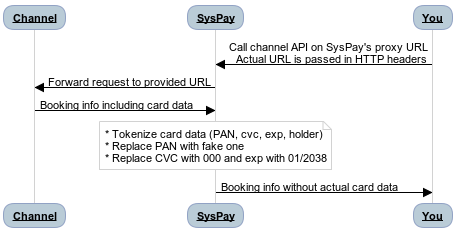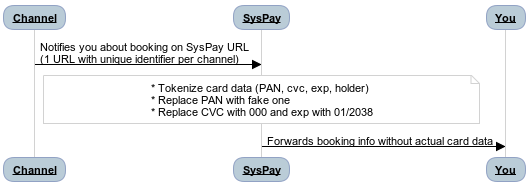Introduction
What is the SysPay PCI Proxy?
Fetching or being pushed booking information that contain card data on your system makes PCI compliance complicated. It extends the scope and increases the number of checks and security controls you have to put in place to meet compliance.
To avoid card data to reach your system, we have developed a man-in-the-middle solution which will take care of extracting card data from the messages exchanged with the various channels you are dealing with, and replace them with tokens that you will organically be able to use with our Hospitality API.

The SysPay's PCI Proxy supports both directions. You can either use it to fetch information from your channels, or to receive notifications from them.
In both cases, the actual card number of the original message will be replaced by a token id that you can use later on with our Hospitality API to create tokens/bookings as usual. The cvc and the card expiration date will be replaced by dummy values. Only the cardholder name will not be changed.
No change will be required to your current Hospitality API implementation as we will automatically detect that the card number you are passing is a PCI Proxy token, and it will be substituted accordingly by the actual card information before being processed.
The OUT flow
That allows you to call remote webservices via SysPay. We will forward your request to the actual end point, extract the card data from the response (if any), replace them with PAN lookalike token ids, and provide you with the sanitized response.

The IN flow
That allows you to receive notifications from remote systems via SysPay. In this case you will use a specific SysPay URL per channel you want us to proxy (provided by us). When we receive a notification from one of these channels, we will extract the card data, replace them with PAN lookalike token ids and forward you the sanitized notification on the URL of your choice.

Usage
OUT flow
Sample request
$ curl -XGET \
-H 'X-PCI-Proxy-Client-Id: xxxx' \
-H 'X-PCI-Proxy-Basic-Authentication: xxxx' \
-H 'X-PCI-Proxy-Forward-To: https://api.channel.com/bookings?since=1503402189' \
https://app.syspay.com/proxy/out
To issue requests through the SysPay PCI Proxy, you will need:
- A PCI Proxy user id
- A password
We will authenticate your calls and know about the final endpoint using the following HTTP headers:
| Header | Value |
|---|---|
| X-PCI-Proxy-Client-Id | Your PCI Proxy user id |
| X-PCI-Proxy-Basic-Authentication | Your PCI Proxy password |
| X-PCI-Proxy-Forward-To | The endpoint to forward the request to |
If the authentication was successful, we will forward your request (including any parameter or custom header that you provided) to the given endpoint. Any card data received in the response will be tokenized, assuming this is for a supported channel and message type. Other messages will be passed without any change.
We will also return the HTTP headers and status code as we have received it from the remote. Errors coming from the PCI Proxy will be returned using specific HTTP headers.
The response will include an extra X-PCI-Proxy-Token-Count header that will contain the number of cards that have been tokenized in the proxied message.
IN flow
You will receive a specific URL to receive notifications for each of the channels you would like to go through us.
This is actually the only change you are required to do to your setup.
Additionaly, the forwarded request will include an extra X-PCI-Proxy-Token-Count header that will contain the number of cards that have been tokenized in the forwarded message.
Integration with the SysPay API
There is no extra work to do to integrate our PCI Proxy with our Hospitality API. The sanitized message will still contain the cards PAN, expiration date, cvc and holder name and can be passed as it to our webservices. They will be automatically recognized and substituted with the actual card data tokenized during the proxy request.
Restrictions
The following restrictions apply to both flows:
- The endpoint we proxy to must respond within 10 seconds (this can be tuned if it's a problem)
- The certificate of that endpoint must be valid
- The communication must be done over HTTPS
Channels
The channels we currently support are:
| Channel | Flow | Notes |
|---|---|---|
| Booking.com | OUT | B_XML Legacy XML |
| Expedia | OUT | QuickConnect Booking Retrieval API |
| TripAdvisor | IN | Instant Booking API |
Errors
If something went wrong while proxying your request, the error will be reported using the following headers:
| Header | Description |
|---|---|
| X-PCI-Proxy-Error-Code | Error code (see table below) |
| X-PCI-Proxy-Error-Message | Error message |
Error codes
The following error codes could be returned:
| Code | Description | Applies to |
|---|---|---|
| 100000 | We couldn't fetch the response from the remote endpoint, for a reason not listed below. | OUT/IN |
| 100001 | The remote certificate is invalid, expired or couldn't be verified | OUT/IN |
| 100002 | The remote hostname could not be resolved | OUT/IN |
| 100003 | The connection to the remote has been refused | OUT/IN |
| 100004 | The connection to the remote timed out | OUT/IN |
| 200000 | The X-PCI-Proxy-Forward-To header is missing | OUT |
| 200001 | The proxy integration could not be found for the given URL | IN |
| 200002 | The remote endpoint is not over HTTPS | OUT/IN |
| 300000 | An error occured during the tokenization process | OUT/IN |

